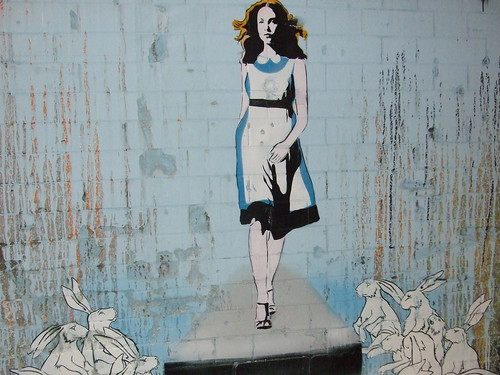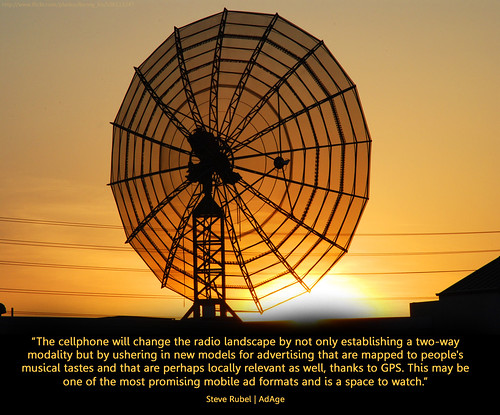I like.
Sunday, 27 July 2008
reflections
Another reason is that at weird times (it's 1am) ideas will pop into my head that I want to get down. So the post was written in a vacuum, save for the various links out to supporting stuff. I didn't check to see if such a thing existed beforehand. That's bad because it could have been and I would have possibly wasted some time and it's good because I am - as we all are - infected by the thoughts of others. It was fresh.
Since writing it, I have had a look around and similar ideas do exist. It's hard being original.
Posted by
Will
at
01:08
0
comments
![]()
![]()
Saturday, 26 July 2008
the digital fitting room
I think so.
After desire comes pragmatics. Does it fit? Does it look good?
If everyone were the same size as the models then all you would do is go and buy the item in that size.
But, of course, everyone isn't the size of a model. Dove niftily profited from that insight with their Campaign for Real Beauty.
Plus, it is one thing to see a model wearing something, another to imagine yourself in it and quite another still to see yourself in it.
It is for this reason fitting rooms exist: so people can test clothes in front of mirrors while trying to look effortlessly blasé about it all (this most bizarre of states is in desperate need of a label. Do the Germans have one, they normally have wonderful words for things like this?)
I would argue that if it weren't for the liberal return policies that e-retail sites have, (which are roughly double the shop rates) clothing would be no way near the second most purchased item online after books. The internet just turns people's homes into their fitting rooms.
Now, no digital experience can recreate the real thing, but I think clothing companies haven't quite got it right online yet.
Just from having a browse around the sites of H&M, Diesel and TopShop it is clear that their digital spaces are sparkly brochures, nothing more.
Even Uniquo's Grand Prix winning Uniqlock - as fresh and tasty as it is - doesn't add a whole lot of value on for their customers. It is not useful to actually buying clothes. Maybe it's not supposed to be. But I think it should.
What would be better? I reckon if people are interested in how clothes look and if they'll fit then all that's needed is a digitisation of the place this happens in: the fitting room.
The Digital Fitting Room can be online, on-phone or on-wall. It simply takes a high-res avatar of you based on either a scan or supplied key dimensions and matches it to the known dimension of clothes. I think the technology is good enough to do this and the demand is certainly there if virtual communities are anything to go by:
"I've also been fascinated to discover how important fashion is within virtual worlds, in which people can dress up their digital avatars and enjoy the benefits of a new outfit or hair-do at a fraction of the cost of the real thing. This is a kind of theatre of virtual consumption, which works in exactly the same way as consumption in the real world – people lust after objects, save up to buy them, and display them with the same pride they would an analogue object....trying on outfits and shopping is one of the great pleasures the world affords its residents, and one of the reasons why Second Life is used by so many women."And it opens up whole new swathes of applications for things like the iPhone (e.g., point it at an item's bar/QR code in-store and see what it would look like on you) or gaming where you get to dress yourself digitally inside of an interesting little game.
The first steps don't have to be as grand as these. They just create engaging and useful interfaces for people to dress themselves and ride off the back off the the popularity of personalisation in the marketplace.
I'd find it useful anyway.
Posted by
Will
at
22:35
1 comments
![]()
![]()
more radioheadness
Posted by
Will
at
12:15
0
comments
![]()
![]()
Thursday, 24 July 2008
knol
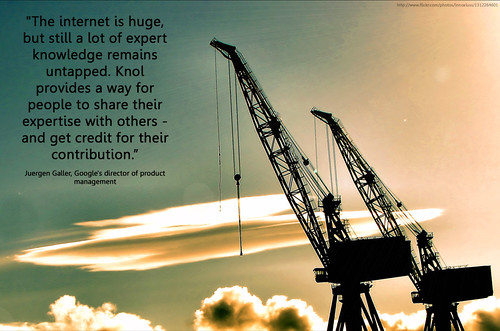
Knol is Wikipedia with three important differences.
1. It adds reputation/authorship more fully into the mix, which improves reliability and drives motivation.
2. It pays you, again, providing more motivation.
3. It is much, much easier to edit unlike that horrible Wikipedia editing interface:
 Good move Google.
Good move Google.
Posted by
Will
at
12:37
0
comments
![]()
![]()
Labels: internet
the future is streaming, not downloading
The news that major ISPs in the UK have agreed to smack the wrists of hardcore file-sharers is, ultimately, not really news.
This is because film, tv and music - the most popular shared content - is increasingly available in streamable form obviating the need to download at all. It's all going to be in the cloud.
The likes of LastFM and Pandora could take care of the music. iPlayer is already taking care of the BBC's output phenomenally well. Other places like TV Shack, Videostic and, legally, Hulu, are providing the rest.
It does tickle me a bit that just as the industry catches up, the ways in which we can consume music has moved on. Instead of owning content - and all the problems that brings if you have acquired it illegally - you just own links to that content and get served with ads or pay a small subscription fee for it.
This shouldn't be a new problem for the entertainment industry, it's a better solution.
Posted by
Will
at
10:46
0
comments
![]()
![]()
Labels: communications, digital, internet, media, mobile, software, technology, video
local cloud dj
"Due to its broadcast nature, the only way to control the mix of music played on the radio is to change stations. Participants came to know what shows would be likely to play music they might like, and not have heard, but found it difficult to fit their time around these programs. Moreover, they might miss or forget the name of the song or band before remembering to buy the music."That is all magically fixed by 'Cloud Music':
"With a number of websites offering [music] free (chiefly LastFM from my usage but also Songza, BoomShuffle, Imeem, SpiralFrog, Qtrax and Pandora), iTunes may even become redundant and the idea of owning a track may be history. Instead, all your music would be within the LastFM (or equivalent) 'cloud', accessible and streamable on whatever your hardware, whenever you want, as long as you are plugged in."In February - when I wrote that - there wasn't really a way to do this. Not easily anyway. However, with typical Apple aplomb democracy has been brought to a previously difficult task with the iPhone 3G. As I went on to say,
"I think 'cloud music' spearheaded by LastFM and others amounts to nothing less than a quiet revolution in the way we consume music and lays down a first draft for the future of music."
Still that leaves the problem of what to listen to; choice can be crippling.
From experience (and research in this paper) it seems most of the new music people get comes their way from a few seriously keen musicologists in their group of friends.
The tyranny of choice places like LastFM offer up may be solved by people like this, as they become curators of the massive databases with constantly morphing playlists, which their friends can tune into. Of course big DJs will still exist - and should move into places like LastFM now and get curating - but the rise of the 'local cloud dj' should happen if 'on-demand' music with 'effectively infinite choice' goes ahead.
As Steve Rubel has said in another article:
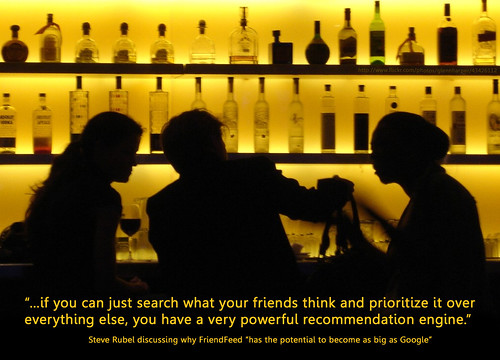
Aye to that.
Posted by
Will
at
02:18
0
comments
![]()
![]()
Wednesday, 23 July 2008
digital bites
 I like making pictures. And anything to do with digital. So I married the two together in a Flickr group.
I like making pictures. And anything to do with digital. So I married the two together in a Flickr group.It started off as just a personal stash of interestingness for someone entering the world of digital to get their head around things.
Then I wondered if (and how) it would spread on the Internet without me promoting it at all. It was an interesting wee experiment just watching various links organically popping up all over the place, the odd twitter/friendfeed/blog mentioning it.
Anyway, people seem to like it. So now I'm moving onto the second part of the experiment: promoting it, which starts with this, a playful little app where all the 'digital bites' can be explored:
www.will-lion.com/digitalbites
Let's see what happens now.
Posted by
Will
at
22:33
0
comments
![]()
![]()
Labels: communications, internet, photography
Sunday, 20 July 2008
futureworld 1
14th January 2009: A couple breaks up because Google Street View reveals he is seeing another woman.
Posted by
Will
at
00:49
0
comments
![]()
![]()
Labels: random
Saturday, 19 July 2008
Friday, 18 July 2008
Monday, 14 July 2008
radioheadness
Radiohead seems bigger than the sum of its parts. I happen to think their music is fantastic but I have just got this niggle that their music alone shouldn't be so big. Isn't it too drony for most people?
With The Tipping Point still kicking about in my mind from a recent re-read I can't help but feel some of their success can be attributed to their seriously innovative activity away from their instruments, like the video above where instead of capturing light bouncing off them (like a camera does) they have captured something else bouncing off and played around with the data. Then there's the web-only free album and all the remixing possibilities they create, like the video above, which comes with Google Code to make your own visualisations. This remix property is something Kevin Kelly predicted:
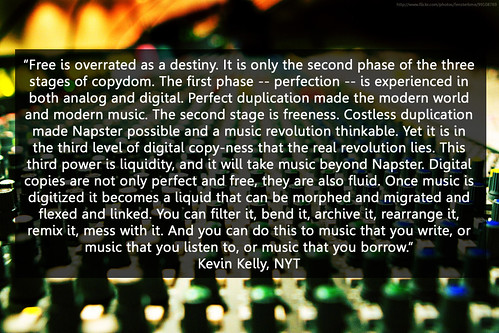
"Once music is digitized it becomes a liquid that can be morphed and migrated and flexed and linked. You can filter it, bend it, archive it, rearrange it, remix it, mess with it." Radiohead seem to be pushing people into this stage; other bands are still coming to grips with stage two, freeness.
Perennially operating on the edge lends a serious ding to the band's cachet. For one, it acts to get the attention of early adopters. It also may create a 'Coke effect'. In blind taste tests most people rate Pepsi as tasting better. When they see the labels Coke is preferred. Brand associations literally change taste perception. Radiohead's associations might literally change music perception or force people to give it 'more of a try' because cool early adopters, people who are serious about music, are serious about Radiohead.
Or maybe the slightly drony alienated sound is just what people like.
(Thanks very much to Faris who mentioned this post on his blog)
Posted by
Will
at
23:59
1 comments
![]()
![]()
Labels: communications, music
Sunday, 22 June 2008
Using the space
 When digital media space is snapped up on a page by the same brand what usually happens is that two identical ads are shoehorned into their respective spaces after a bit of resizing. That's filling the space. In the Mac ad above the two spaces speak to each other in a meaningful way making the whole ad more engaging. That's using the space.
When digital media space is snapped up on a page by the same brand what usually happens is that two identical ads are shoehorned into their respective spaces after a bit of resizing. That's filling the space. In the Mac ad above the two spaces speak to each other in a meaningful way making the whole ad more engaging. That's using the space.
Posted by
Will
at
00:33
0
comments
![]()
![]()
Labels: communications, media
Friday, 13 June 2008
Digital is different
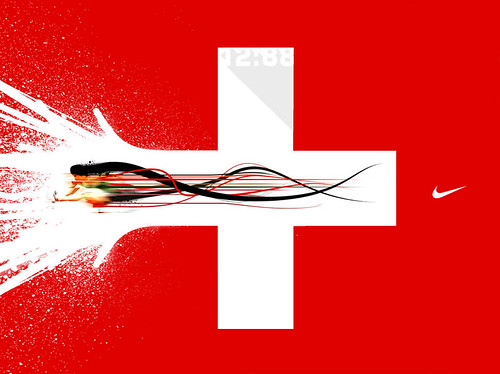 jellymon/Flickr
jellymon/FlickrIn this article in AdAge (Google cache version here), Robert Rosenthal, former president of TBWA/Chiat/Day Latin America, is highly skeptical of what "online advertising [is] actually delivering...." He notes that there is no proper Internet branding to speak of, "[c]an you think of even one "Just do it"...that came from advertising on the web?"
I think this makes the error of thinking about new media by the standards of the old media. It's the view that expects brands to be announcing what they are about the whole time, instead of, well, just doing it. Simply put, it's the expectation of messages where services are more appropriate (and appreciated).
So, there may not be a "Just do it" but there is a Nike+.
As the NYT says, "Behind the shift is a fundamental change in Nike’s view of the role of advertising. No longer are ads primarily meant to grab a person’s attention while they’re trying to do something else — like reading an article. Nike executives say that much of the company’s future advertising spending will take the form of services for consumers, like workout advice, online communities and local sports competitions.
"“We want to find a way to enhance the experience and services, rather than looking for a way to interrupt people from getting to where they want to go,” said Stefan Olander, global director for brand connections at Nike. “How can we provide a service that the consumer goes, ‘Wow, you really made this easier for me’?”"
TV may be the major place for yaddering on about brands and what they stand for but digital offers other ways of making businesses grow - and growth is what 'advertising' has to be aiming to engender.
Posted by
Will
at
23:32
0
comments
![]()
![]()
Labels: communications, digital
